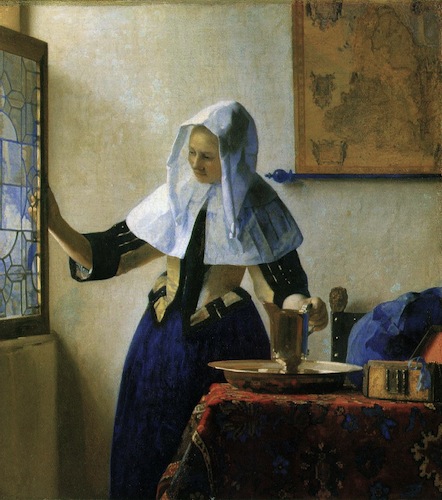When I was at university I overheard a conversation when someone said:
I just don’t understand how you can say you like both the Pre-Raphaelites and Vermeer.
It has stuck with me ever since. It’s just a perfect one-line bit of art criticism. It always seemed like it ought to make a great parlour game†: ‘I just don’t understand how you can say you like both x and y… fill in the blanks.’ But actually I’ve never been able to find a pair which seems as perfect as Vermeer and the Pre-Raphs.

Vermeer basically painted accurate pictures of his own time and place; carefully composed, tidied up and idealised, perhaps, but realistic, small scale, domestic. The Pre-Raphaelites‡ chose to retire to a silly fantasy world of knights and maidens which avoided the difficult complex reality of the nineteenth century — but avoided the difficult complex reality of the medieval world as well.
And Vermeer is sensual but austere; sensual in his representation of surfaces, textures, light and shadow, but stylistically austere in his classically perfect compositions and controlled, precise brushwork. While the Pre-Raphaelites are the opposite: stylistically they are lush and decorative, but the result is bloodless. Their paintings are full of decorative young men and women posturing and looking glamorous, but it’s all surface. There’s no flesh to it, not a whiff of filth.
In one of Aldous Huxley’s early novels, which are satirical portraits of London bohemia, there’s a character called Casimir Lypiatt who sees himself in the Renaissance tradition of painter-poet-thinkers, full of bombastic rhetoric about Art and Beauty and moral significance. Not everyone is as impressed with him as he is:
‘Number seventeen,’ said Mrs Viveash, ‘is called “Woman on a Cosmic Background.”’ A female figure stood leaning against a pillar on a hilltop, and beyond was a blue night with stars. ‘Underneath is written: “For one at least, she is more than the starry universe.”’ Mrs Viveash remembered that Lypiatt had once said very much that sort of thing to her. ‘So many of Casimir’s things remind me,’ she said, ‘of those Italian vermouth advertisements. You know – Cinzano, Bonomelli and all those. I wish they didn’t. This woman in white with her head in the Great Bear….’ She shook her head. ‘Poor Casimir.’
Presumably Huxley, writing in 1923, was not thinking of the pre-Raphaelites. But that description is brutally spot on.

Vermeer took the small and mundane and made it something hypnotic; the Pre-Raphaelites took a grand mixture of ideas, ideals, myth and history, and made a lot of pretty posters.
* OK, maybe ‘hate’ is a bit strong. But, you know, linkbait innit.
† Actually, thinking about it, a truly dreadful parlour game. A mildly interesting intellectual exercise, maybe.
‡ Yes, I know, I’m lumping them all together in a rather lazy way. But although the exact details varied from painter to painter, and some were better than others, I think the broad argument applies to all of them.